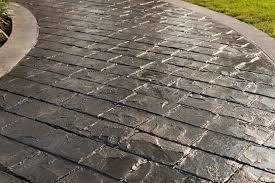Homeowners in Bluffton, South Carolina, face unique challenges when selecting outdoor surface materials. The Lowcountry’s humid subtropical climate, sandy soils, and occasional extreme weather events require materials that can withstand both daily wear and seasonal extremes. Stamped concrete has emerged as an ideal solution, offering the aesthetic appeal of premium materials with the durability and practicality that coastal living demands.
Stamped concrete in Bluffton allows you to achieve the look of expensive stone, brick, or tile while providing superior performance in Bluffton’s challenging environment. This innovative technique transforms ordinary concrete into stunning surfaces that resist moisture, salt air, and temperature fluctuations that can damage other materials. From poolside patios to front walkways, stamped concrete creates beautiful outdoor spaces that enhance your home’s value and your family’s enjoyment.
This comprehensive guide explores why stamped concrete works so well in Bluffton’s unique environment and how to maximize its benefits for your property. You’ll discover design possibilities, understand the installation process, and learn maintenance strategies that keep your investment looking beautiful for decades.
Understanding Bluffton’s Environmental Challenges
Climate and Weather Considerations
Bluffton’s location in the South Carolina Lowcountry creates specific environmental conditions that affect outdoor materials. The area experiences hot, humid summers with temperatures often exceeding 90°F and high humidity levels that can cause materials to expand and contract. These conditions, combined with frequent afternoon thunderstorms, create moisture challenges that many traditional materials struggle to handle.
Hurricane season brings additional concerns, with strong winds and flooding potential that can damage poorly installed surfaces. Stamped concrete’s monolithic nature provides superior resistance to these extreme weather events compared to segmented materials like pavers or natural stone that can shift or wash away during storms.
Winter temperatures rarely drop below freezing, but the occasional cold snap can create freeze-thaw cycles that affect some materials. Stamped concrete’s solid structure and proper installation techniques provide excellent resistance to these temperature variations, maintaining its integrity and appearance year-round.
Soil and Foundation Considerations
The Lowcountry’s sandy soils offer both advantages and challenges for concrete installations. Sandy soil provides excellent drainage, reducing water accumulation problems common in clay-heavy regions. However, this same drainage can lead to settling issues if proper preparation isn’t followed.
Experienced contractors understand that Bluffton’s soil conditions require specific base preparation techniques. They incorporate proper compaction methods and sometimes add stabilizing materials to ensure long-term stability. This attention to foundation preparation prevents common problems like cracking or uneven settling that can occur with inadequate site preparation.
Coastal proximity brings additional considerations, including salt air exposure that can affect some materials over time. Stamped concrete’s solid surface and protective sealers provide excellent resistance to salt air corrosion, making it ideal for properties near the coast or waterways.
Design Possibilities for Bluffton Homes
Popular Pattern Options
Stamped concrete offers numerous pattern options that complement Bluffton’s architectural styles. Cobblestone patterns create charming Old World appeal that works beautifully with traditional Southern architecture. These patterns provide visual interest while maintaining the practical benefits of a solid surface.
Slate and flagstone patterns offer sophisticated elegance perfect for upscale properties. These natural stone replicas provide the refined appearance of expensive materials while offering superior durability and lower maintenance requirements. The patterns work particularly well for pool decks and entertaining areas where both beauty and functionality are essential.
Brick patterns remain popular choices for their classic appeal and versatility. Whether you prefer traditional running bonds or more elaborate herringbone designs, stamped concrete can replicate brick’s appearance while eliminating common brick problems like efflorescence, shifting, or weed growth between joints.
Color Integration Strategies
Color selection plays a crucial role in stamped concrete success. Earth tones like warm browns, tans, and grays complement Bluffton’s natural landscape while providing timeless appeal that won’t look dated as trends change. These colors also hide minor staining and wear better than lighter options.
Integral color mixing ensures consistent color throughout the concrete thickness, preventing chipping or wear from exposing different colored concrete underneath. This technique provides superior long-term appearance compared to surface-only coloring methods that can wear away over time.
Accent coloring and antiquing techniques add depth and realism to stamped patterns. These specialized techniques create natural-looking variations that mimic the subtle color differences found in real stone or brick, enhancing the overall aesthetic appeal of your installation.
Installation Process and Timing
Site Preparation Requirements
Proper site preparation forms the foundation of successful stamped concrete installation. This process begins with accurate excavation to appropriate depths, typically 4-6 inches for most residential applications. Contractors must account for both the concrete thickness and any base material requirements.
Drainage considerations are particularly important in Bluffton’s climate. Proper grading directs water away from concrete surfaces, preventing pooling that can lead to staining or structural problems. Experienced contractors incorporate subtle slopes and drainage features that manage water effectively while maintaining attractive appearances.
Base material selection depends on specific site conditions and intended use. Some installations require compacted gravel bases for additional stability, while others can be placed directly on properly prepared soil. Professional contractors assess each site individually to determine optimal preparation methods.
Concrete Mixing and Placement
Quality concrete mixing is essential for stamped concrete success. Contractors must specify appropriate concrete strengths and additives for local conditions. This includes air entrainment for freeze-thaw protection and plasticizers for improved workability during the stamping process.
Timing becomes critical during placement and stamping. Contractors monitor weather conditions and adjust schedules accordingly. High temperatures and humidity can accelerate concrete setting, requiring experienced crews who can complete stamping operations within appropriate time windows.
The stamping process itself requires skilled craftspeople who understand proper techniques for achieving consistent patterns and textures. This includes proper stamp placement, pressure application, and release agent use to ensure professional results across the entire surface area.
Maintenance and Longevity
Protective Sealing Requirements
Sealing represents one of the most important maintenance aspects for stamped concrete in Bluffton’s environment. Quality sealers protect against moisture penetration, UV damage, and staining while enhancing color and pattern definition. The humid climate and frequent rain make this protection particularly valuable.
Sealer selection depends on desired appearance and performance characteristics. Some sealers provide natural, matte finishes while others offer enhanced gloss that intensifies colors. Professional contractors can recommend appropriate sealer types based on your specific installation and aesthetic preferences.
Resealing schedules typically range from 2-4 years depending on traffic levels and weather exposure. High-traffic areas may require more frequent attention, while protected areas often extend longer between applications. Regular sealing maintains both appearance and protection, maximizing your investment’s lifespan.
Cleaning and Routine Care
Routine cleaning keeps stamped concrete looking its best while preventing problems that can develop over time. Regular sweeping removes debris that can cause staining or surface abrasion. Occasional pressure washing removes accumulated dirt and organic growth that can affect appearance.
Prompt attention to spills and stains prevents permanent damage. Most stains can be removed with appropriate cleaning products and techniques when addressed quickly. Professional contractors provide specific cleaning recommendations based on your installation type and local conditions.
Seasonal maintenance includes inspecting for minor cracks or surface wear that might require professional attention. Early identification and repair of small problems prevents more extensive damage that could require costly repairs or replacement.
Cost Considerations and Value
Investment Comparison
Stamped concrete typically costs more than basic concrete but significantly less than premium natural materials it replicates. When comparing costs, consider both initial installation expenses and long-term maintenance requirements. Stamped concrete often provides better value than alternatives when evaluated over its entire lifespan.
Installation costs vary based on pattern complexity, color requirements, and site conditions. Simple patterns with single colors cost less than elaborate designs with multiple colors and special effects. However, even complex stamped concrete installations typically cost less than equivalent natural stone or high-end paver installations.
Long-term value includes both maintenance savings and property value enhancement. Stamped concrete’s durability and low maintenance requirements provide ongoing savings compared to materials that require frequent repairs or replacement. Quality installations also enhance property values, making them smart financial investments.
Property Value Enhancement
Professional stamped concrete installations enhance property values by creating attractive outdoor spaces that extend living areas. These improvements appeal to potential buyers while providing immediate enjoyment for current owners. The combination of beauty and functionality makes stamped concrete a wise investment choice.
Outdoor living spaces continue gaining popularity, making quality hardscape improvements increasingly valuable. Stamped concrete patios, walkways, and pool decks create functional areas that families use regularly while contributing to overall property appeal and marketability.
Maximizing Your Stamped Concrete Investment
Stamped concrete in Bluffton offers Bluffton homeowners an exceptional combination of beauty, durability, and value. Its ability to withstand the Lowcountry’s challenging climate while providing the appearance of premium materials makes it an ideal choice for various outdoor applications.
Success depends on working with experienced contractors who understand local conditions and proper installation techniques. Take time to research contractors thoroughly, examining their portfolios and speaking with previous customers about their experiences and satisfaction levels.
Quality stamped concrete installations provide decades of beauty and service with minimal maintenance requirements. The initial investment pays dividends through enhanced property values, reduced maintenance costs, and increased outdoor living enjoyment. When properly installed and maintained, stamped concrete becomes a permanent enhancement that your family will enjoy for years to come.
Contact Info:
Name : Crystal Creek Concrete
Address : 20952 Ward Rd, Woodburn, IN 46797
Phone: +1 (260) 241-4936
Email: loren@crystalcreekconcrete.com
Website: https://crystalcreekconcrete.com/






